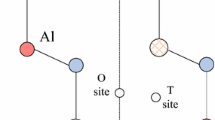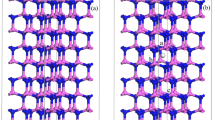Abstract
InGaAsP photocathodes show great potential for near-infrared applications, particularly at 1.06 μm. However, vacancy defects are unavoidable in InGaAsP crystals during their growth. Various defective models were constructed for In0.84375Ga0.125As0.25P0.75, In0.875Ga0.09375As0.25P0.75, In0.875Ga0.125As0.21875P0.75 and In0.875Ga0.125As0.25P0.71875 to study In, Ga, As and P vacancy defect influences respectively on In0.875Ga0.125As0.25P0.75 bulk properties. The electronic structure, formation energy, Mulliken population, electron density difference, and optical properties of defective crystals were calculated from first principles. Results show that In0.875Ga0.125As0.25P0.71875 has the lowest formation energy, implying that P vacancy defect is most easy formed. In and Ga vacancies are negatively charged and act as acceptors, whereas As and P vacancies are positively charged and act as donors. Increased populations of Ga-P and In-P bonds around the vacancies strengthen the covalency. In and Ga vacancies in the low-energy region significantly improve optical conductivity, reflectivity, and introduce new abnormal dispersion. Although As and P vacancies do not change the dispersion properties in the low energy region, they increase the refractive index.






Similar content being viewed by others
Data availability
The raw/processed data required to reproduce these findings cannot be shared at this time as the data also forms part of an ongoing study.
References
Giudicotti, L., Pasqualo, R., Alfier, A., Beurskens, M., Kempenaars, M., Flanagan, J.C., Walsh, M.J., Balboa, I.: Near-infrared detectors for ITER LIDAR Thomson scattering. Fusion Eng. Des. 86, 198–205 (2011). https://doi.org/10.1016/j.fusengdes.2010.12.055
K.A. Mcintosh, J.P. Donnelly, D.C. Oakley, A. Napoleone, D.C. Shaver, Development of Geiger-mode APD arrays for 1.06 μm. In: Proc LEOS Annual Meeting. 2 (2002). 760–761. https://doi.org/10.1109/LEOS.2002.1159529.
Olsen, G.H., Szostak, D.J., Zamerowski, T.J., Ettenberg, M.: High-performance GaAs photocathodes. J. Appl. Phys. 48, 1007–1008 (1977). https://doi.org/10.1063/1.323798
Sun, Y., Kirby, R.E., Maruyama, T., Mulhollan, G.A., Bierman, J.C., Pianetta, P.: The surface activation layer of GaAs negative electron affinity photocathode activated by Cs, Li, and NF3. Appl. Phys. Lett. 95, 174109 (2009). https://doi.org/10.1063/1.3257730
Blankemeier, L., Rezaeifar, F., Garg, A., Kapadia, R.: Integrated photonics for low transverse emittance, ultrafast negative electron affinity GaAs photoemitters. J. Appl. Phys. 126, 33102 (2019). https://doi.org/10.1063/1.5093938
André, J.P., Guittard, P., Hallais, J., Piaget, C.: GaAs photocathodes for low light level imaging. J. Cryst. Growth. 55, 235–245 (1981). https://doi.org/10.1016/0022-0248(81)90293-1
James, L.W., Antypas, G.A., Moon, R.L., Edgecumbe, J., Bell, R.L.: Photoemission from cesium-oxide-activated InGaAsP. Appl. Phys. Lett. 22, 270–271 (1973). https://doi.org/10.1063/1.1654634
Dolia, R., Bhardwaj, G., Singh, A.K., Kumar, S., Alvi, P.A.: Optimization of Type-II ‘W’ shaped InGaAsP/GaAsSb nanoscale-heterostructure under electric field and temperature. Superlattices Microstruct. 112, 507–516 (2017). https://doi.org/10.1016/j.spmi.2017.10.007
Xi, S.P., Gu, Y., Zhang, Y.G., Chen, X.Y., Ma, Y.J., Zhou, L., Du, B., Shao, X.M., Fang, J.X.: InGaAsP/InP photodetectors targeting on 1.06μm wavelength detection. Infrared Phys. Technol. 75, 65–69 (2016). https://doi.org/10.1016/j.infrared.2015.12.013
Adachi, S.: In: Kasap, S., Capper, P. (eds.) III-V ternary and quaternary compounds BT-springer handbook of electronic and photonic materials, pp. 735–752. Springer, Boston (2007)
Escher, J.S., Antypas, G.A., Edgecumbe, J.: High-quantum-efficiency photoemission from an InGaAsP photocathode. Appl. Phys. Lett. 29, 153–155 (1976). https://doi.org/10.1063/1.89005
Bacuyag, D., Escaño, M.C.S., David, M., Tani, M.: First-principles study of structural, electronic, and optical properties of surface defects in GaAs(001)β2(2x4). AIP Adv. 8, 65012 (2018)
Rouzhahong, Y., Wushuer, M., Mamat, M., Wang, Q., Wang, Q.: First principles calculation for photocatalytic activity of GaAs monolayer. Sci. Rep. 10, 9597 (2020). https://doi.org/10.1038/s41598-020-66575-9
Escaño, M.C., Balgos, M.H., Nguyen, T.Q., Prieto, E.A., Estacio, E., Salvador, A., Somintac, A., Jaculbia, R., Hayazawa, N., Kim, Y., Tani, M.: True bulk As-antisite defect in GaAs(110) identified by DFT calculations and probed by STM/STS measurements. Appl. Surf. Sci. 511, 145590 (2020). https://doi.org/10.1016/j.apsusc.2020.145590
Clark, S., Segall, M., Pickard, C., Hasnip, P., Probert, M., Refson, K., Payne, M.: First principles methods using CASTEP. Z. Kristallogr. 220, 567–570 (2005). https://doi.org/10.1524/zkri.220.5.567.65075
Floris, A., Timrov, I., Himmetoglu, B., Marzari, N., de Gironcoli, S., Cococcioni, M.: Hubbard-corrected density functional perturbation theory with ultrasoft pseudopotentials. Phys. Rev. B. 101, 064305 (2020)
Escaño, M., Nguyen, T., Osanai, Y., Kasai, H., Tani, M.: Large-scale spin-polarized DFT calculation of electronic properties of GaAs with defects. Mater. Res. Express. 6, 055914 (2019). https://doi.org/10.1088/2053-1591/ab0640
Albavera-Mata, A., Botello-Mancilla, K., Trickey, S., Gázquez, J., Vela, A.: Generalized gradient approximations with local parameters. Phys. Rev. B 102, 035129 (2020). https://doi.org/10.1103/PhysRevB.102.035129
Querales, J., Ventura, C., Fuhr, J.: Effect of N interstitial complexes on the electronic properties of GaAs1-xNx alloys from first principles. Phys. Rev. Mater. 3, 24602 (2019). https://doi.org/10.1103/PhysRevMaterials.3.024602
Pack, J., Monkhorst, H.: “Special points for Brillouin-zone integrations”—a reply. Phys. Rev. B-Phys. Rev. B 16, 1748–1749 (1977). https://doi.org/10.1103/PhysRevB.16.1748
Glisson, T.H., Hauser, J.R., Littlejohn, M.A., Williams, C.K.: Energy bandgap and lattice constant contours of III-V quaternary alloys. J. Electron. Mater. 7, 639–646 (1978). https://doi.org/10.1007/bf02655439
Komsa, H.-P., Pasquarello, A.: Comparison of vacancy and antisite defects in GaAs and InGaAs through hybrid functionals. J. Phys. Condens. Matter. 24, 45801 (2012). https://doi.org/10.1088/0953-8984/24/4/045801
Bagayoko, D.: A mathematical solution to the theoretical band gap underestimation: predictive calculations of properties of semiconductors. Am. J. Phys. 1, 15–35 (2008)
Ma, D., Cheng, J., Zhang, J., Cao, Y., Li, E.: The influence of the Cu doping position on GaAs: first-principles calculations. Mater. Today Commun. 25, 101549 (2020). https://doi.org/10.1016/j.mtcomm.2020.101549
Koppolu, U.M.K.: Electronic band structure and complex dielectric function of zb-AlP: a first principles study. Acta Phys. Pol. A 136, 486–489 (2019). https://doi.org/10.12693/APhysPolA.136.486
Seifert, S., Runge, P.: Revised refractive index and absorption of In1-xGaxAsyP1-y lattice-matched to InP in transparent and absorption IR-region. Opt. Mater. Express. 6, 629–639 (2016). https://doi.org/10.1364/OME.6.000629
Acknowledgements
This work was financed by the National Natural Science Foundation of China (Grant No. 61971386), Public Welfare project of Ningbo City (202002N3139, 2019C10051).
Author information
Authors and Affiliations
Corresponding author
Additional information
Publisher's Note
Springer Nature remains neutral with regard to jurisdictional claims in published maps and institutional affiliations.
Rights and permissions
Springer Nature or its licensor (e.g. a society or other partner) holds exclusive rights to this article under a publishing agreement with the author(s) or other rightsholder(s); author self-archiving of the accepted manuscript version of this article is solely governed by the terms of such publishing agreement and applicable law.
About this article
Cite this article
Wang, Y., Li, J., Zhang, J. et al. Vacancy defect influences on optoelectronic properties for In0.875Ga0.125As0.25P0.75: a first-principles study. Opt Rev 30, 166–173 (2023). https://doi.org/10.1007/s10043-023-00797-w
Received:
Accepted:
Published:
Issue Date:
DOI: https://doi.org/10.1007/s10043-023-00797-w




